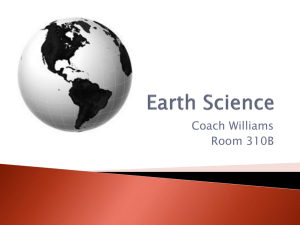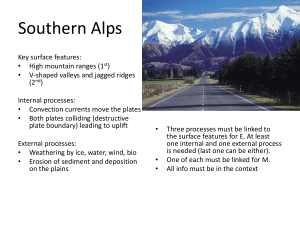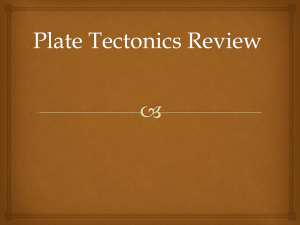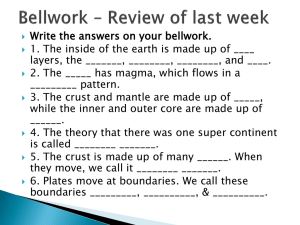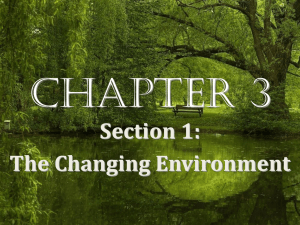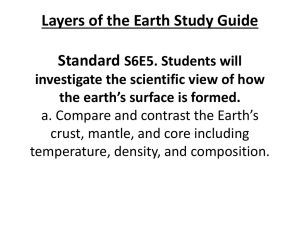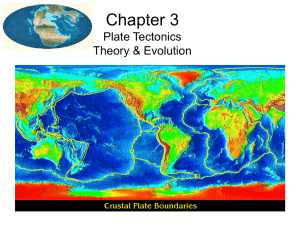Chapter 2 - Dublin City Schools
advertisement
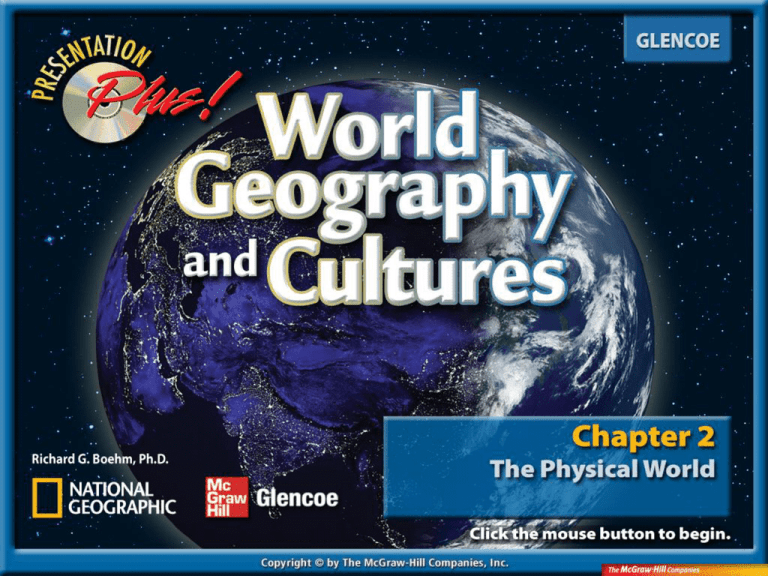
Introduction Section 1: Planet Earth Section 2: Forces of Change Section 3: Earth’s Water Summary Physical processes shape Earth’s surface. Understanding that Earth is part of a larger physical system called the solar system helps us understand how life on our planet is possible. Earth’s physical are affected by natural forces such as earthquakes and volcanoes that can influence human activities on the planet. Section 1: Planet Earth As a physical system, what makes Earth suitable for plant and animal life? Planet Earth As a physical system, what makes Earth suitable for plant and animal life? Planet Earth • hydrosphere • continental shelf • lithosphere • atmosphere • biosphere • approach • assistance • features Planet Earth A. Isthmus of Panama B. Sinai Peninsula C. Mount Everest D. Dead Sea E. Mariana Trench Planet Earth Which of the following is at the center of our solar system? A. Earth 0% A D. Moon C C. Mars A. A B. B 0% C. C 0% B B. Sun Our Solar System Earth is part of a larger physical system that contains other planets, moons, and stars. • At least eight planets exist, and each is in its own orbit around the sun: – Mercury – Jupiter – Venus – Saturn – Earth – Uranus – Mars – Neptune Our Solar System (cont.) • Ceres and Pluto are dwarf planets. • All of the planets are grouped into two types—terrestrial and gas giant planets. • Thousand of smaller objects— including asteroids, comets, and meteoroids—revolve around the sun. The Solar System Which of the following is defined as pieces of space debris—chunks of rock and iron? A.Asteroids B.Comets C.Meteorites D. Solar Flares A. A B. B 0%C. 0% C A B 0% C Getting to Know Earth Earth’s surface is a complex mix of landforms and water systems. • About 70% of the surface of the Earth is made up of water and is called the hydrosphere. • About 30% of the surface of the Earth is land, including continents and islands. • The air we breathe is part of the Earth’s atmosphere. Water, Land, and Air Getting to Know Earth (cont.) • The part of the Earth that supports life is the biosphere. • Landforms – Landforms and bodies of water are the natural features of the Earth’s surface. – Underwater landforms are as diverse as those found on dry land. – Seen from space, Earth’s most visible landforms are the seven continents. Underwater Landforms Getting to Know Earth (cont.) • Earth’s Heights and Depths – The highest point on Earth is Mount Everest, which is 29,028 feet above sea level. – The lowest dry land point is the shore of the Dead Sea, which is 1,349 feet below sea level. – Earth’s deepest known depression is the Mariana Trench, which is 35,827 feet deep. Which term is the name for the Earth’s crust? A. Hydrosphere B. Lithosphere C. Atmosphere D. Biosphere 0% A A. B. C. 0% D. B A B C 0% D C 0% D Section 2: Forces of Change Earth’s internal and external forces Forces of Change How have internal and external forces shaped Earth’s surface? Forces of Change • core • mantle • crust • continental drift • plate tectonics • magma • subduction • accretion • spreading • fold • fault • faulting • weathering • erosion • glacier • moraine Forces of Change A. Himalaya B. San Andreas Fault C. Kōbe D. San Francisco E. Ring of Fire F. Greenland G. Antarctica Earth’s Structure The Earth’s internal and external structure, including the tectonic plates, is responsible for the creation of continents, oceans, and mountain ranges. • The Earth is composed of three main layers: – The core – The mantle – The crust Inside the Earth Earth’s Structure (cont.) • Many scientists believe that most of the landmasses forming our present-day continents were once part of one gigantic supercontinent called Pangaea. • Due to continental drift, they slowly separated. • Due to plate tectonics, the physical features of the planet are constantly changing. The thick layer of hot, dense rock describes which of the following terms? A. Core B. Mantle C. Crust D. Atmosphere 0% A A. A B. B C.0%C B 0% C Internal Forces of Change Plate tectonics is responsible for folding, lifting, bending, and breaking parts of the Earth’s surface. • Mountains are formed when: – giant continental plates collide – a sea plate collides with a continental plate (called subduction) Continental Drift Internal Forces of Change (cont.) • During accretion, continents can grow outward. • If two sea plates converge, an island chain may form. • If spreading occurs, the magma that rises will form undersea volcanic mountains or ridges and some islands. Plate Movement Internal Forces of Change (cont.) • Folds and Faults – Moving plates may squeeze the Earth’s surface until it buckles (called folds). – Plates may also grind or slide past each other, creating cracks in the Earth’s crust (called faults). Internal Forces of Change (cont.) • Earthquakes – Sudden, violent movements of tectonic plates along a fault line are known as earthquakes. – The Ring of Fire is one of the most earthquake-prone areas on the planet. Internal Forces of Change (cont.) • Volcanic Eruptions – Volcanoes are mountains formed by lava or by magma that breaks through the Earth’s crust. Forces of Change If a heavier sea plate dives beneath the lighter continental plate, the process is known as which term? A. Subduction 0% D 0% A D. Faulting A B C 0% D C C. Spreading A. B. C. 0% D. B B. Accretion External Forces of Change External forces such as weathering and erosion also shape the surface of the Earth. • The Earth is changed by two basic kinds of weathering: – Physical weathering – Chemical weathering External Forces of Change (cont.) • Wind Erosion – Wind erosion involves the movement of dust, sand, and soil from one place to another. External Forces of Change (cont.) • Glacial Erosion – As glaciers move, they may destroy forests, carve out valleys, alter courses of rivers, and wear down mountaintops, changing the landscape. – There are two types of glaciers: • Sheet glaciers • Mountain glaciers External Forces of Change (cont.) • Water Erosion – Water erosion begins when springwater and rainwater flow downhill in streams, cutting into the land, and wearing away the soil and rock. • Soil Building – Soil building is the product of thousands of years of weathering and biological activity. – Rocks are broken down into smaller pieces through weathering. Living organisms break down dead plant and animal material. Section 3: Earth’s Water Physical processes that keep the Earth’s water constant. Earth’s Water What physical processes keeps Earth’s water constant? Earth’s Water • water cycle • desalination • evaporation • condensation • precipitation • groundwater • • aquifer Earth’s Water A. Pacific Ocean B. Atlantic Ocean C. Indian Ocean D. Arctic Ocean E. Mediterranean Sea F. Gulf of Mexico Earth’s Water The total amount of water on earth A. Always changes. B. Never changes. C. Sometimes changes. D. None of the above A. A B. B 0% C.0%C A B 0% C The Water Cycle The amount of water on Earth remains fairly constant and moves in the water cycle. • The Earth’s water is constantly moving—from the oceans to the air to the land and finally back to the ocean. The Water Cycle (cont.) • The process involves: – Evaporation – Condensation – Precipitation The Water Cycle In which part of the water cycle does vapor change back into liquid? A. Evaporation B. Condensation C. Precipitation D. Pasteurization 0% A A. A B. B C.0%C B 0% C Bodies of Salt Water Salt water covers much of the Earth’s surface. • Oceans – About 97% of the Earth’s water is saltwater in the form of oceans, seas, gulfs, and bays. Bodies of Salt Water (cont.) • The five oceans are: – The Pacific – The Atlantic – The Indian – The Arctic – The Southern Bodies of Salt Water (cont.) • Salt Water to Freshwater – Today, efforts focus on ways to meet the world’s increasing need for freshwater, such as turning ocean water into freshwater by removing the salt (called desalination). Desalination Through Distillation Which ocean is the largest? A. Pacific B. Atlantic C. Indian D. Arctic 0% A A. B. C. 0% D. B A B C 0% D C 0% D Bodies of Freshwater Although there is a small amount of freshwater on Earth, it is necessary to sustain life. • Lakes, Streams, and Rivers – Lakes, streams, and rivers contain less than 1% of the Earth’s freshwater. Bodies of Freshwater (cont.) • Groundwater – About 0.5% of the Earth’s freshwater is found beneath the surface also called groundwater. – Wells and springs tap into groundwater and are important sources of freshwater for people. How much of the Earth’s total water supply is freshwater? A. 1% B. 2% C. 3% D. 4% 0% A A. B. C. 0% D. B A B C 0% D C 0% D Review Planet Earth • Earth is the third planet from the sun in our solar system. It is one of 4 planets with a solid, rocky crust, and the only planet with liquid water on its surface. • Earth’s proximity to the sun allows for liquid water on the surface needed to sustain life. • Earth also has an atmosphere that protects life from the harmful effects of the sun and keeps the Earth at a temperature suitable for a variety of life forms. Forces of Change • The Earth is shaped by internal and external forces. • Inside the Earth is a superheated, solid inner core. A liquid outer core is covered by the hot rock of the mantle. • The Earth’s crust, made up of more than a dozen slabs, rests on a melted layer of mantle. These slabs move around the globe, creating physical features. • Wind and water erosion shape the surface of the Earth. Earth’s Water • The water cycle keeps Earth’s water constantly moving—water evaporates from oceans, lakes and streams. Then it cools, becomes condensation, and falls to Earth as precipitation. • Most of Earth’s water is found in the oceans. The rest is frozen in glaciers, found underground, or in lakes, rivers and streams. • Because most of Earth’s water is salty ocean water, people have found a way to remove the salt from water. Desalination is expensive, but useful in places where freshwater is scarce. hydrosphere the watery areas of the earth, including oceans, lakes, rivers, and other bodies of water lithosphere surface land areas of the earth’s crust, including continents and ocean basins atmosphere a layer of gases that surrounds the Earth biosphere the part of the Earth where life exists continental shelf the part of a continent that extends underwater core the innermost layer of the Earth. Made up of a super-hot but solid inner core and a liquid outer core mantle thick middle layer of the Earth’s interior structure, consisting of dense, hot rock crust the rocky shell forming the Earth’s surface continental drift the theory that the continents were once joined and then slowly drifted apart plate tectonics the term scientists use to describe the activities of continental drift and magma flow which create many of Earth’s physical features magma molten rock that is pushed up from the Earth’s mantle subduction a process by which mountains can form as sea plates dive beneath continental plates accretion a slow process in which a sea plate slides under a continental plate, creating debris that can cause continents to grow outward spreading a process by which new land is created when sea plates pull apart and magma wells up between the plates fold a bend in layers of rock, sometimes caused by plate movement fault a crack or break in the Earth’s crust faulting a process of cracking that occurs when folded land cannot be bent any further weathering chemical or physical processes, such as freezing, that break down rocks erosion wearing away of the Earth’s surface by wind, flowing water, or glaciers glacier large body of ice that moves across the surface of the earth moraine piles of rocky debris left by melting glaciers water cycle regular movement of water from ocean to air to ground and back to the ocean evaporation process of converting into vapor condensation the process of excess water vapor changing into liquid water when warm air cools precipitation moisture that falls to the earth as rain, sleet, hail, or snow desalination the removal of salt from seawater to make it usable for drinking and farming groundwater water within the Earth that supplies wells and springs aquifer underground water-bearing layers of porous rock, sand, or gravel To navigate within this Presentation Plus! product: Click the Forward button to go to the next slide. Click the Previous button to return to the previous slide. Click the Return button to return to the main presentation. Click the Home button to return to the Chapter Menu. Click the Help button to access this screen. Click the Exit button or press the Escape key [Esc] to end the chapter slide show. Links to Maps in Motion, static maps and charts, and transparencies appear near the bottom of slides as they are relevant. Links to the Reference Atlas and Geography Online are located on the navigation bar of most screens. This slide is intentionally blank.
